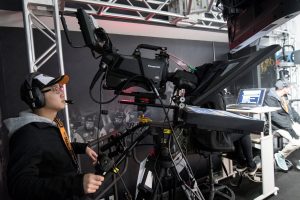Rochester Institute of Technology Upgrades Productions With Panasonic UC3000 4K/HD Cams
Story Highlights
For more than 15 years, Rochester Institute of Technology (Rochester, NY) has aired SportsZoneLive, first as a weekly half-hour show showcasing the university’s athletic programs, then expanded to broadcasting live sporting events (including Division 1 Hockey) in conjunction with Time Warner and now the CW Network. (RIT has also added a live pregame show and streams multiple RIT sports via its OTT platform.)
The university has recently upgraded its broadcast trailer — a full production studio — with the addition of Panasonic AK-UC3000 4K/HD studio camera systems and AW-HE130 pan/tilt/zoom cameras. The 24’ trailer features six AK-UC3000 4K/HD camera systems as main cameras, ten AW-HE130 FHD pan/tilt/zoom cameras and several LCD broadcast monitors for production, engineering, and camera shading. All operate under in-arena IP control, complementing these cameras’ capabilities.
“After nearly a decade of robust performance from our prior generation of Panasonic cameras — P2 HD AG-HPX500s — it was time for a broadcast solution that would prepare us for eventual 4K production,” says James Bober, Assistant Director/Chief Engineer, University Production Services, Marketing and Communications Division. “The UC3000 camera system — supporting both 4K and HD acquisition — is an excellent fit for our educational environment, which demands longevity from our equipment investments.”
“And because the UC3000’s built-in optical conversion lens allows standard 2/3” B4 mount lenses to be used, we have been able to re-purpose all our HD glass on the new camera bodies,” he continues. “We can enjoy the economies of a staggered implementation of cameras and lenses as we move towards full 4K production.”
Bober explained that during games, all six UC3000s are set up in manned studio or handheld configurations throughout the campus’ new Gene Polisseni Center, a 4000+-seat multipurpose hockey arena. While each of the cameras is capable of wired operation, one UC3000 is deployed as a wireless RF cam using an IMT integrated microwave system.
The exact positioning of the UC3000s and HE130s in the hockey arena is as follows: Cam 1 High Wide (UC3000), Cam 2 High tight (UC3000), Cam 3 Slash South (UC3000), Cam 4 Slash North (UC3000), Cam 5 Pregame set (UC3000), Cam 6 Wireless (UC3000), Cam 7 Center Ice (PTZ), Cam 8 Broadcast Booth (PTZ), Cam 9 Reverse Angle (PTZ), Cam 10 Team locker room (PTZ), Cam 11 North Arena Wide (PTZ), Cam 12 Pregame set (PTZ), Cam 13 Crowd East (PTZ), Cam 14 Crowd West (PTZ), Cam 15 Goal Cam North (PTZ), and Cam 16 Goal Cam South (PTZ).
 Bober said that with two control rooms — one for in-house video, the second for TV broadcasts — camera resources can be simultaneously shared. For instance, many of the PTZ cameras perform dual roles depending on the needs of two different directors. Many of the cameras have significantly different assignments contingent on whether situation is game play or between game periods. To accomplish the multiple implementations, RIT has separate robotic camera control stations that are program-specific and can control all the PTZs simultaneously.
Bober said that with two control rooms — one for in-house video, the second for TV broadcasts — camera resources can be simultaneously shared. For instance, many of the PTZ cameras perform dual roles depending on the needs of two different directors. Many of the cameras have significantly different assignments contingent on whether situation is game play or between game periods. To accomplish the multiple implementations, RIT has separate robotic camera control stations that are program-specific and can control all the PTZs simultaneously.
“It’s challenging for the manned camera ops but the UC3000’s multiple intercom channel capability allows both control rooms to communicate with camera ops based on need,” Bober notes.
The new Panasonic cameras were installed in advance of the 2018-2019 hockey season, which began September 30. At the conclusion of hockey play late winter, the equipment will be used for lacrosse coverage. Bober noted that the previous HPX500 camcorders have been repurposed for Division 3 broadcasts (including basketball, baseball, and soccer) via OTT web streaming.
“The UC3000s and HE130s have been performing flawlessly,” he notes. “RIT has been investing in Panasonic for more than 16 years, and the price/performance of the company’s products, across the board, has been superb.”
“What makes our broadcast trailer special goes beyond state-of-the-art technology,” he adds. “Students are largely responsible for planning and building out the trailer — and for running the show during live broadcasts — all of which gives them industry experience that is changing and molding their whole careers. What students learn in a classroom can only take them so far. What we provide is a down-to-earth application that gives them an edge.”

